
This Day in SIA

Road to the First Soroptimist Club Meeting and Beyond
Throughout our year long 100th anniversary celebration, SIA will share pieces of our story, highlighting momentous occasions from our bright past. While some events are large and some are small, they all lead to where we are today—celebrating 100 years!
Follow SIA on social media and use the hashtag #ThisDayinSIA to see more photos and history.
Let’s journey back together through time as we reveal events leading up to the very first club meeting, starting with what happened on May 31, 1921.
May 31, 1921
We aren’t sure of the exact date when Stuart Morrow, a past organizer of Rotary clubs, walked into Parker-Goddard Secretarial School in Oakland, California. During that visit, Adelaide Goddard, one of the two women who owned the school, inspired Morrow to consider a club for business and professional women, similar to Rotary. But we are sure when Morrow started the effort to form such a club.
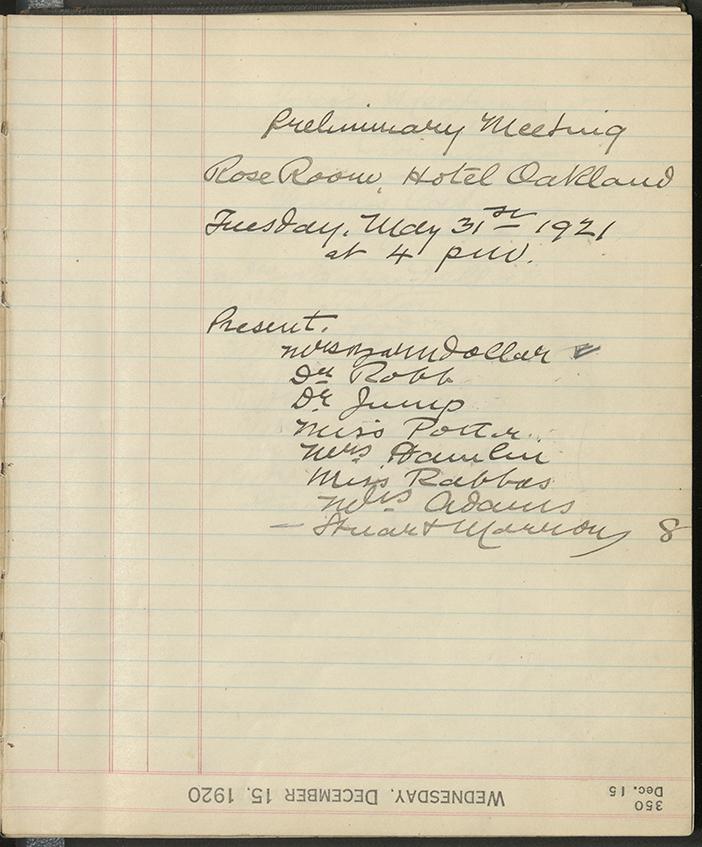
This image from the “Morrow Book” in the Soroptimist Archives documents the formation of the first Soroptimist club. It shows on May 31, 1921, that Morrow was joined at 4:00 p.m. in the Rose Room of the Hotel Oakland by seven women from the community: Mrs. Barndollar, Dr. Robb, Dr. Jump, Miss Porter, Mrs. Hamlin, Miss Rabbas, and Mrs. Adams.
There are no other minutes of the meeting, and of the seven women gathered, only Gladys Barndollar, a printer, went on to become a charter member of the new Soroptimist club.
June 11, 1921
Gladys Barndollar, one of the women who attended the preliminary meeting on May 31, submitted her membership application on June 11, 1921 (although she did not pay her $15 dues until September), and was one of the nine women who attended the next organizational meeting on June 21, 1921.
June 21, 1921
This day in SIA history marked the first official meeting of the women’s service group, which still had not been named. Set in a private room at the Venus Café on Tuesday, June 21, at 12:15 p.m., Stuart Morrow met with nine women to discuss the formation of the new club. The club followed the custom of the Rotary Clubs Morrow was familiar with, and limited membership to one representative of each professional classification and designation.
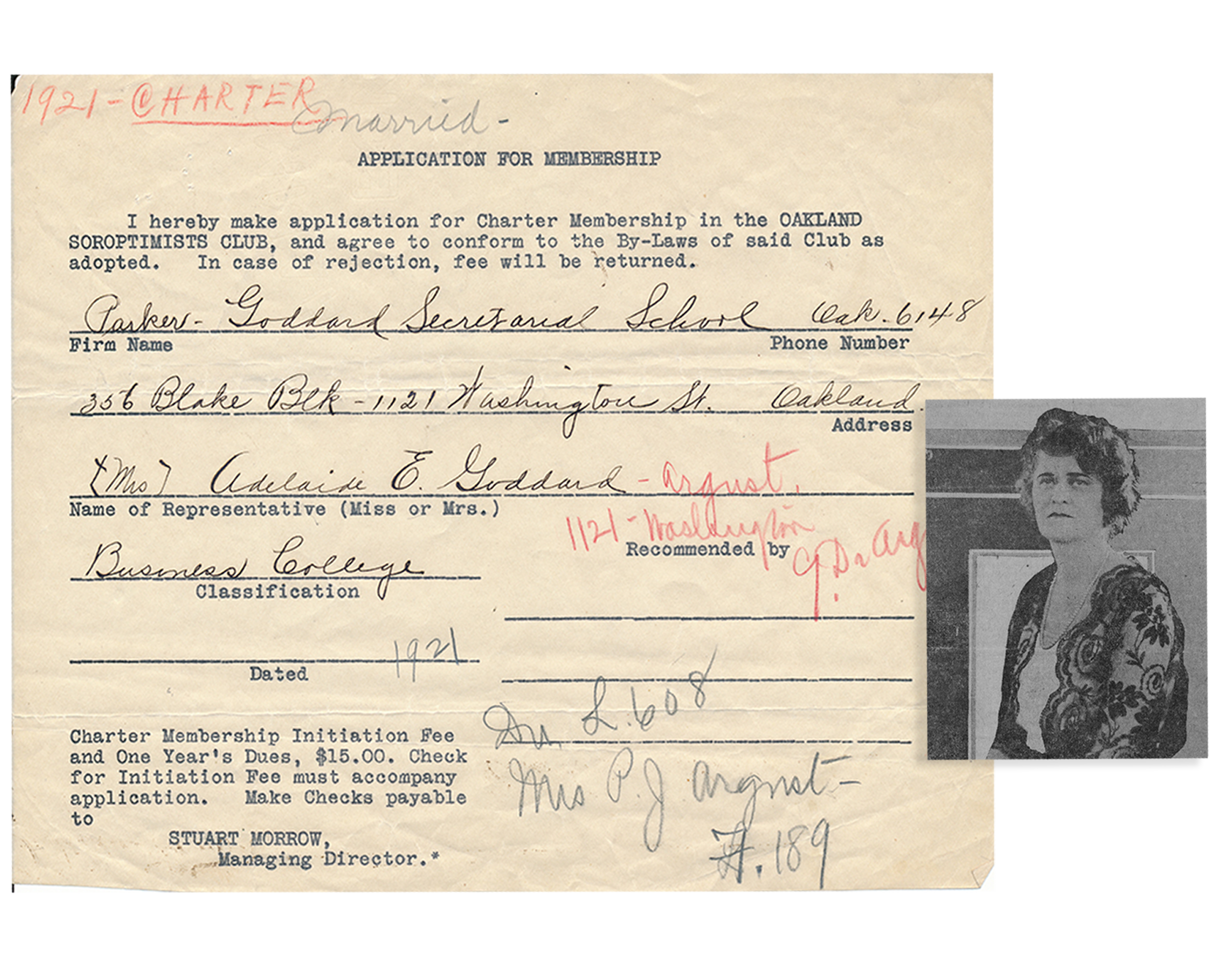
In attendance were Soroptimist charter members:
- Mrs. Gladys Barndollar (Multigraphing)
- Mrs. Doris Tilton (Skin and Scalp Treatment, Principal)
- Mrs. Adelaide Goddard (Business College, Partner)
- Mrs. Grace Wetterhall (Real Estate, Principal)
- Mrs. Mary Hughes Patterson (Piano Teacher, Principal)
- Mrs. Mae Green Lineker (Optometrist, Principal)
- Mrs. Blanche Rollar (Corsets and Blouses, Proprietor)
Other attendees included Mrs. Lillian Blake (Art Dealer, Proprietor), who attended other organizational meetings after paying her dues in June but was mysteriously not listed on the club’s charter; and Mrs. Miller, who did not become a member.
June 27, 1921
The first regular luncheon to organize the first Soroptimist club was held at 12:15 p.m. on Monday, June 27, in the Blue Room of the Hotel Oakland. Before this day, the group had met on Tuesdays, but Monday became the new meeting day of the week with this meeting.
Organizer Stuart Morrow’s notes from the meeting show the members assembled determined their name badges should be orange with blue lettering. The group also decided not to meet on the Fourth of July holiday.
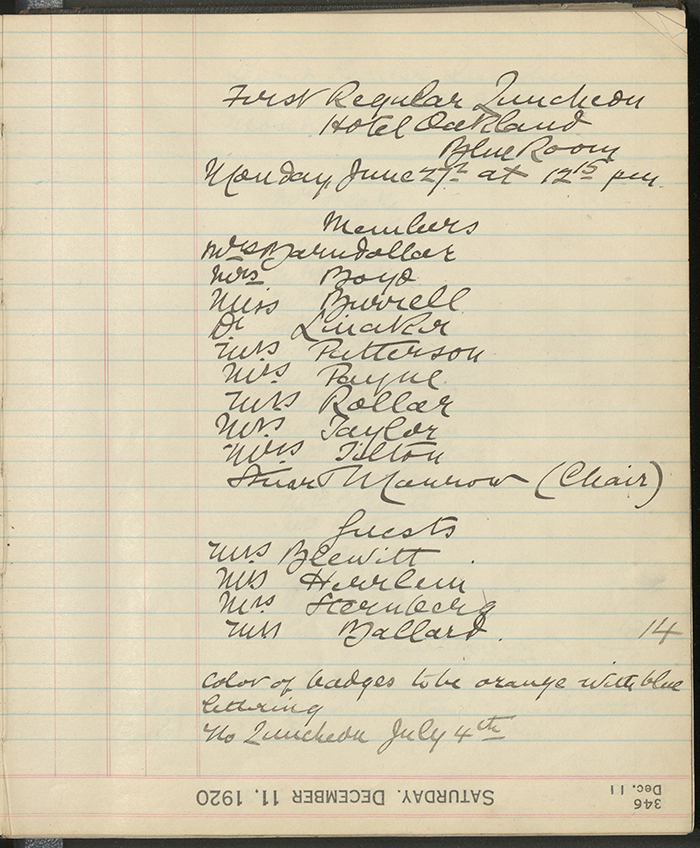
Members present at the meeting were:
- Mrs. Gladys Barndollar (Multigraphing)
- Mrs. Ruth Boyd (Photographer-Portraits, Manager)
- Mrs. Florence Burrell (Physical Therapeutics, Principal),
- Dr. Mae Green Lineker (Optometrist, Principal)
- Mrs. Mary Hughes Paterson, (Piano Teacher, Principal)
- Miss Lydia Payne (Funeral Director, Assistant)
- Miss Blanche Rollar (Corsets and Blouses, Proprietor)
- Mrs. Ella Taylor (Funeral Director, Partner)
- Mrs. Doris Tilton (Skin and Scalp Treatment, Principal)
Four guests also attended the meeting, and all eventually became members:
- Mrs. Mertie Blewitt (Photographer-Commercial, Partner)
- Mrs. Etta Herrlein (Milliner-Single Piece, Principal)
- Mrs. Sylvia Sternberg (Hemstitching, Pleating and Buttons, Proprietor)
- Miss Sue Ballard (Men’s Hats, Partner)
While we don’t know for certain, it may be that member Ruth Boyd recommended Mertie Blewitt given that both women were photographers. And Blanche Rollar, who was in the garment industry, recommended Sylvia Sternberg—and possibly Etta Herrlein and Sue Ballard—who were also in that industry.
July 11, 1921
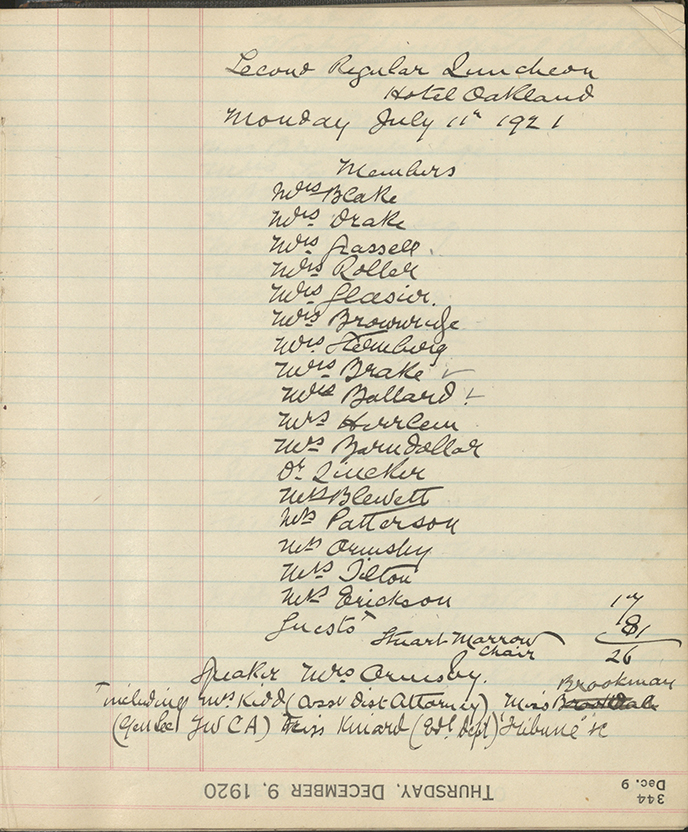
After taking a week’s break in recognition of the Fourth of July holiday, the second regular luncheon of the Alameda County Soroptimist club took place on July 11, 1921, at the Hotel Oakland.
Seventeen members attended this meeting. Of this group, eight members were first-time attendees and nine members* had attended a meeting previously:
- Lillian Blake (Art Dealer, Proprietor)
- Nellie Drake (Caterer, Principal)
- Regina Grassel (Costumer, Proprietor)
- Blanche Rollar*
- Louise Glasier (Dentistry, Partner)
- Lillian Brownridge (Hydro and Electro Therapeutics, Proprietor)
- Sylvia Sternberg*
- Fannie Brake (Ladies Furnishings, Partner)
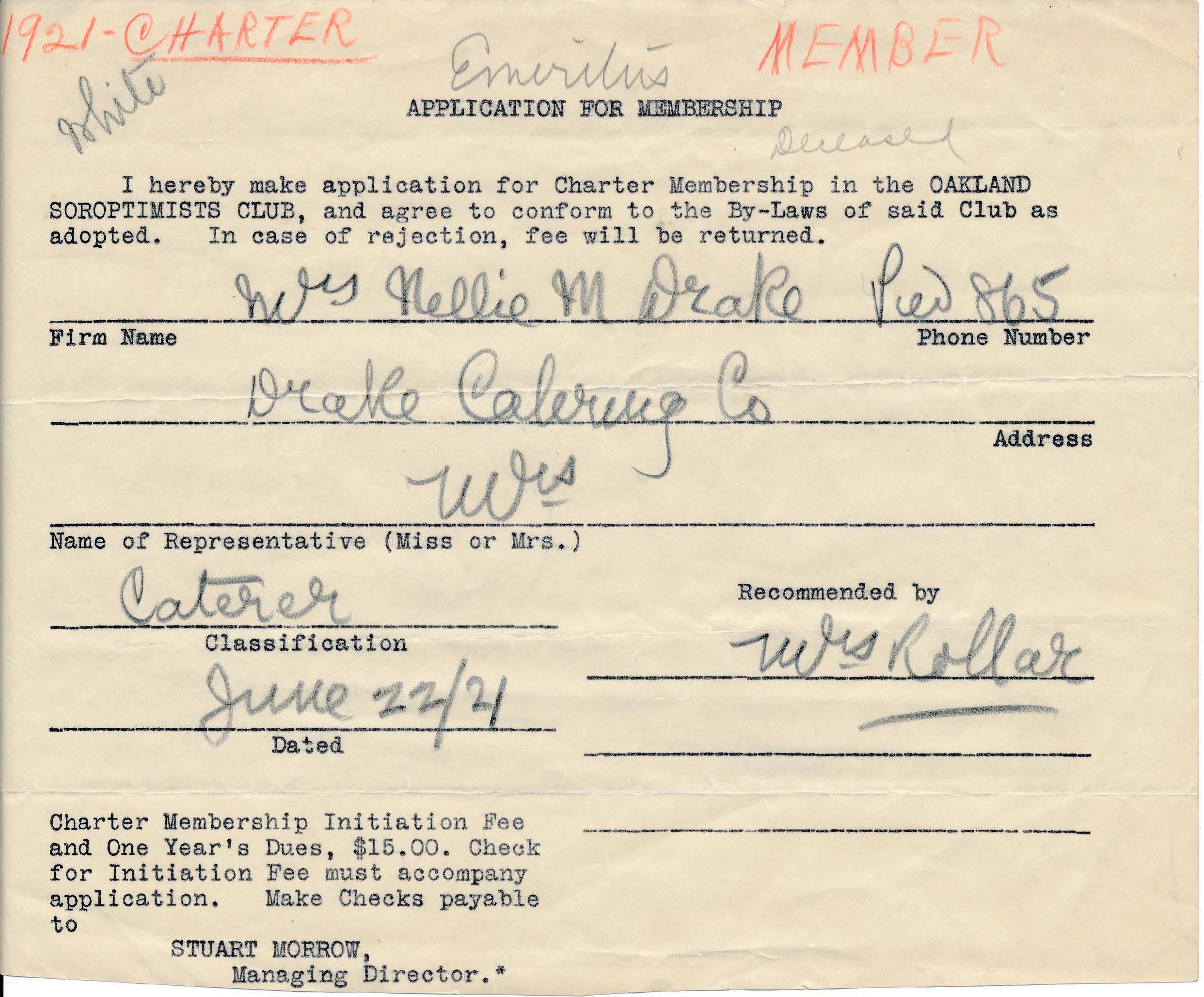
Nellie Drake's application for membership. Nellie was a caterer. - Sue Ballard*
- Etta Herrlein*
- Gladys Barndollar*
- Mae Green Lineker*
- Mertie Blewett*
- Mary Hughes Patterson*
- Georgia Ormsby (School Director, Principal)
- Doris Tilton*
- Meta Erickson (Railroad President, Corporate Officer)
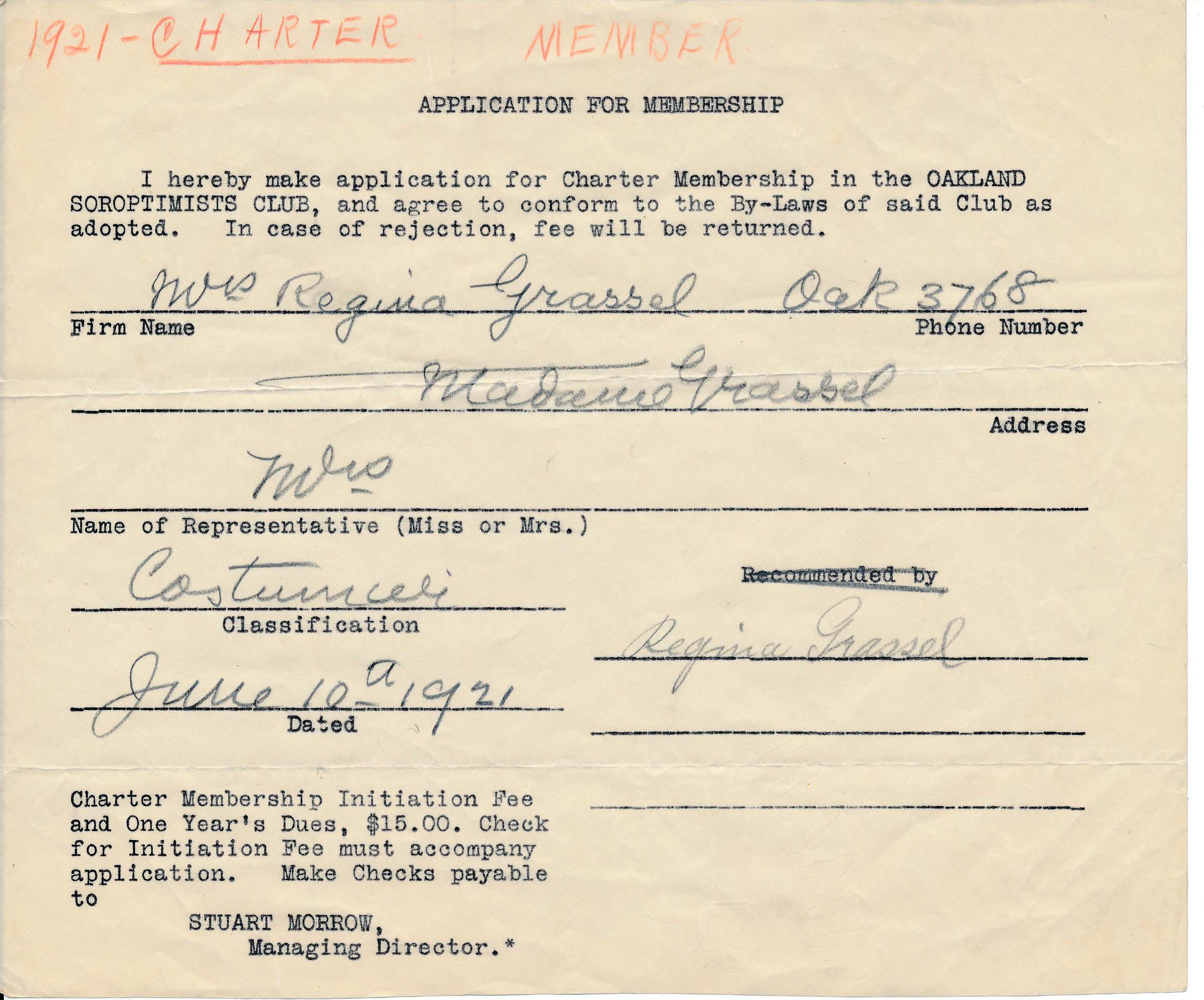
The first-time attendees reached into new areas of women’s professional life, including dentistry and art, as well as the only woman railroad president in the world at that time.
Georgia Ormsby served as the meeting’s speaker, and a number of guests attended as well, including the Associate District Attorney, Mrs. Kidd, and Miss Brookman, who was affiliated with the YWCA. Miss Bookman who would be a guest in the future as well. Neither of these women became members, but another named guest, Miss Kinard, a journalist for The (Oakland) Tribune newspaper, later joined in September.
July 18, 1921
The third regular luncheon during the formation of the Alameda County Soroptimist club was held on this day at the Hotel Oakland.
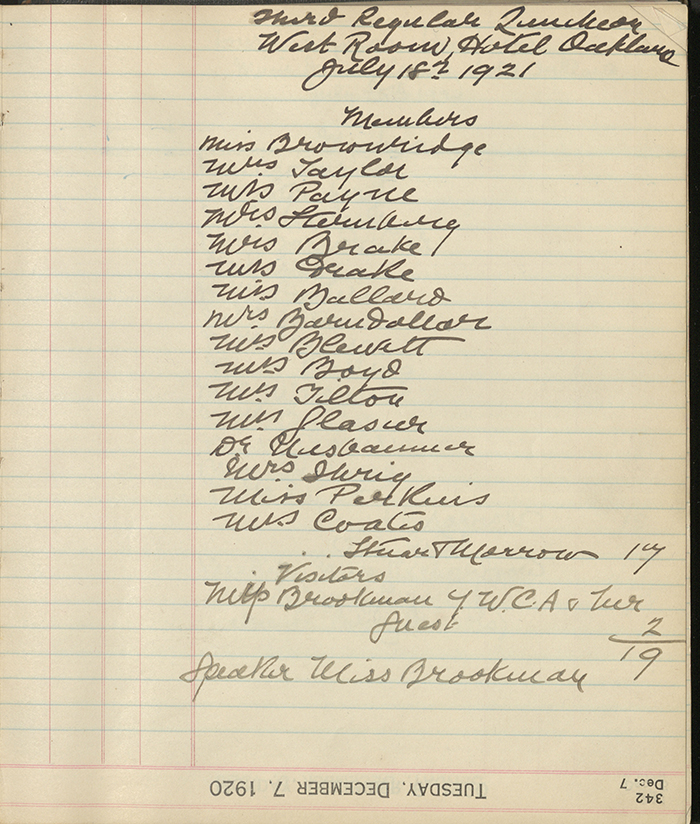
Sixteen members were in attendance. First-time attendees included:
- Pauline Nusbaumer, M.D. (Laboritarian, Corporate Officer)
- Anna Ihrig (Art Needlework, Proprietor)
- Minnette Perkins (Optician, Corporate Officer)
- Hannah Coates (Publisher-songs and poems, Partner)
They were joined by Lillian Brownridge, Ella Taylor, Lydia Payne, Sylvia Sternberg, Fannie Brake, Nellie Drake, Sue Ballard, Gladys Barndollar, Mertie Blewett, Ruth Boyd, Doris Tilton, and Louise Glasier.
A repeat visitor was Miss Brookman from the YWCA, who also served as the meeting’s speaker. While Miss Brookman would not become a charter member, the connection to the YWCA would be important in a few months, as the newly chartered club embarked on its first club project. Stay tuned for more about that!
July 25, 1921
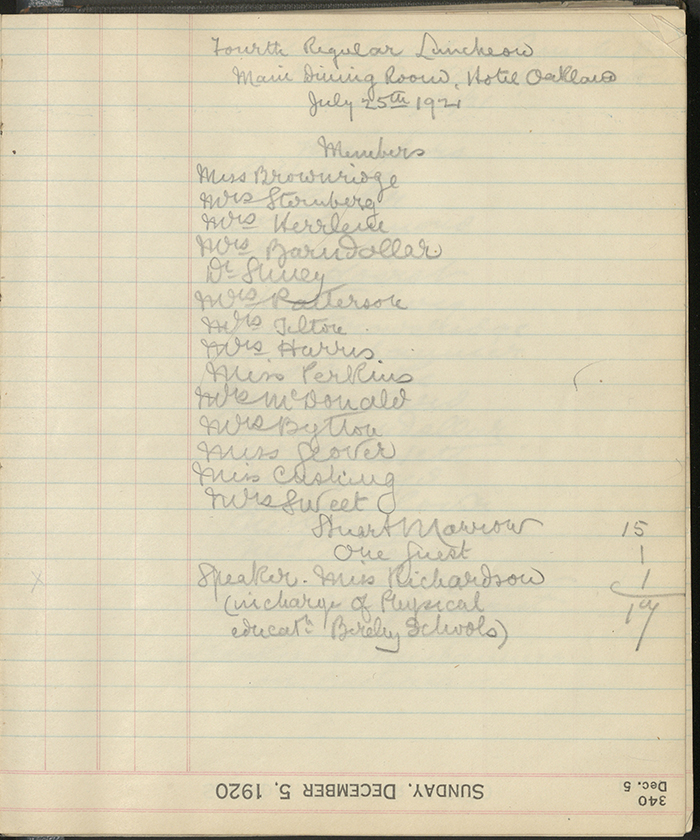
The fourth regular luncheon of the Alameda County Soroptimist club was held today at the Hotel Oakland.
As in earlier weeks, the group was still quite small with just 14 members present. Seven members were attending for the first time and seven had attended at least one prior meeting.
Attending for the first time were:
- Sarah Shuey, M.D. (Physician, Principal)
- Lavinia Harris (Automatic Water Heaters “Hoffman”, Partner)
- Maud McDonald (Sheet Metal Contractor, Partner)
- Martha Bytton (Milliner-General, Proprietor)
- Anne Glover (Printer, Proprietor)
- Eloise Cushing (Attorney-at-Law, Principal)
- Jane Sweet (Dancing Teacher, Partner)
Welcoming these new members were Lillian Brownridge, Sylvia Sternberg, Etta Herrlein, Gladys Barndollar, Mary Hughes Patterson, Doris Tilton, and Minnette Perkins.
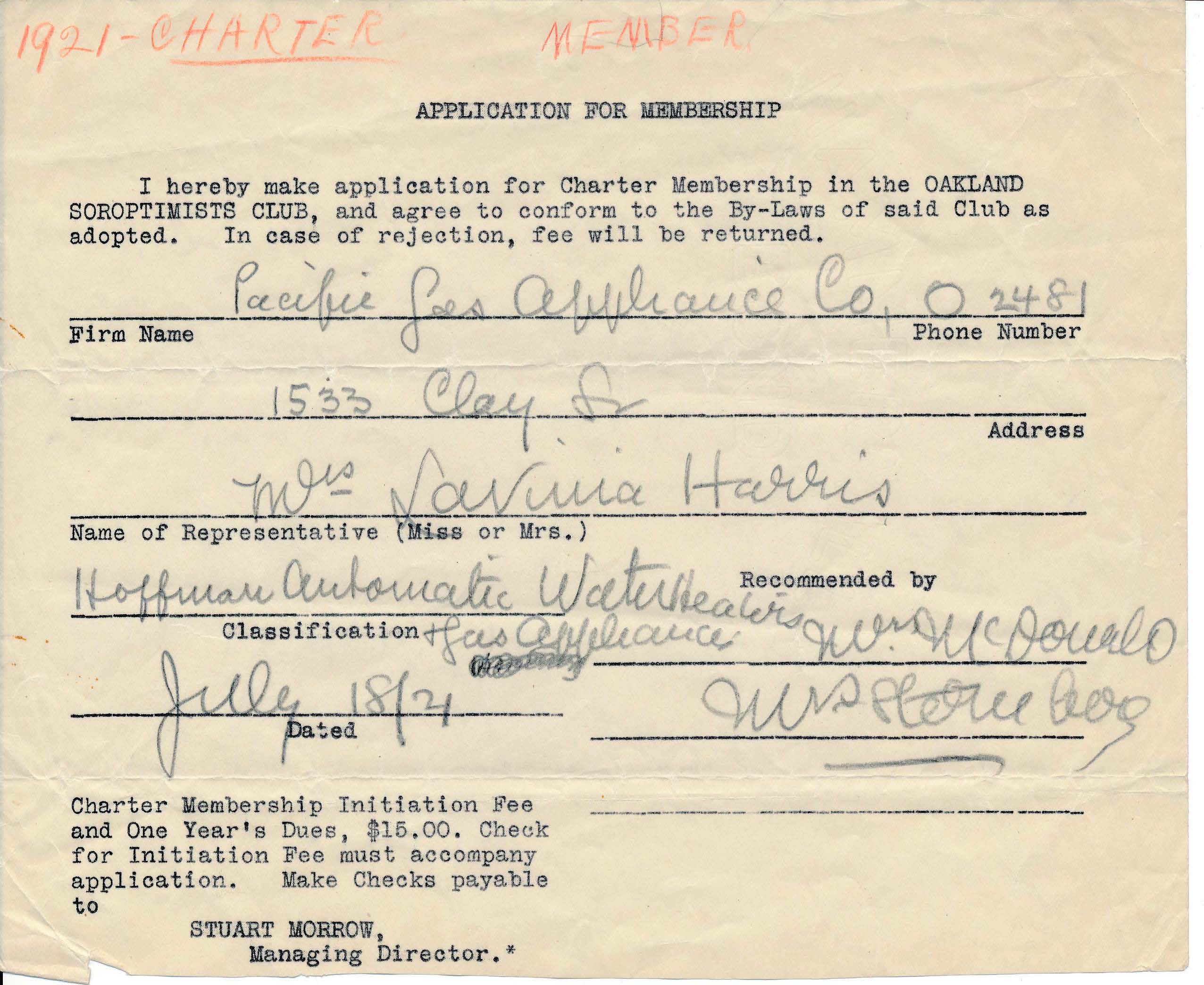
The addition of two members who were partners (presumably in a family business) in the building trades is noteworthy, and indicative that many family businesses relied on the labor of wives or daughters to manage certain aspects of the business. Lavinia Harris’s membership application shows she was recommended by another first-time attendee, Maud McDonald, as well as Sylvia Sternberg.
The “classification” of members by profession was also showing the ability to stretch. The addition of a Milliner-General (Martha Bytton) came after a Milliner-Single Price (Etta Herrlein) was already among the membership.
This meeting also introduced attendees to two women whose names would become well-known throughout Soroptimist as it grew. Miss Violet Richardson, then unmarried (and as Stuart Morrow noted, “in charge of physical education” with the Berkeley Schools), was the featured speaker that day. And Eloise Cushing, an attorney who would leave her mark on the organization through her skills at writing governance documents, attended for the first time as a member.
August 1, 1921
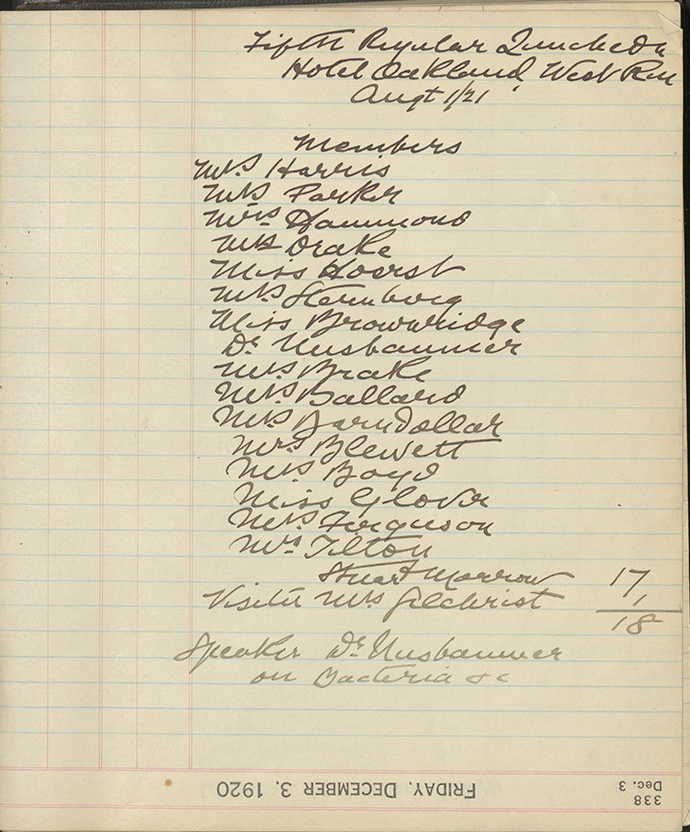
The fifth regular luncheon of the Alameda County Soroptimist club at the Hotel Oakland marked the unofficial
half-way point in the club’s development. Stuart Morrow had been working for two months to establish the first club, with another two months to go before it officially chartered. There would be seven more regular luncheon meetings to come as the club focused on member recruitment.
During this meeting, four members attended for the first time: Myrtle Parker (Banjo, Mandolin, Guitar and Hawaiian Instruments, Principal), Sarah Hammond (Cafeteria, Partner), Esther Hoerst (Engineering College, Corporate Officer), and Clara Ferguson (Sanitarium-Christian Science, Proprietor).
In addition, there were 11 returning members: Lavinia Harris, Nellie Drake, Sylvia Sternberg, Lillian Brownridge, Pauline Nusbaumer, Fannie Brake, Sue Ballard, Mertie Blewett, Ruth Boyd, Doris Tilton, and the stalwart Gladys Barndollar. By now, some of the names would be familiar as many had attended multiple meetings, showing a strong affinity for the club—whether to build professional networks or to simply be in the presence of other business and professional women and expand their friendships.
Pauline Nusbaumer, M.D., the corporate officer for a medical laboratory, was the featured speaker. She spoke “on Bacteria,” as noted by Morrow.
August 8, 1921
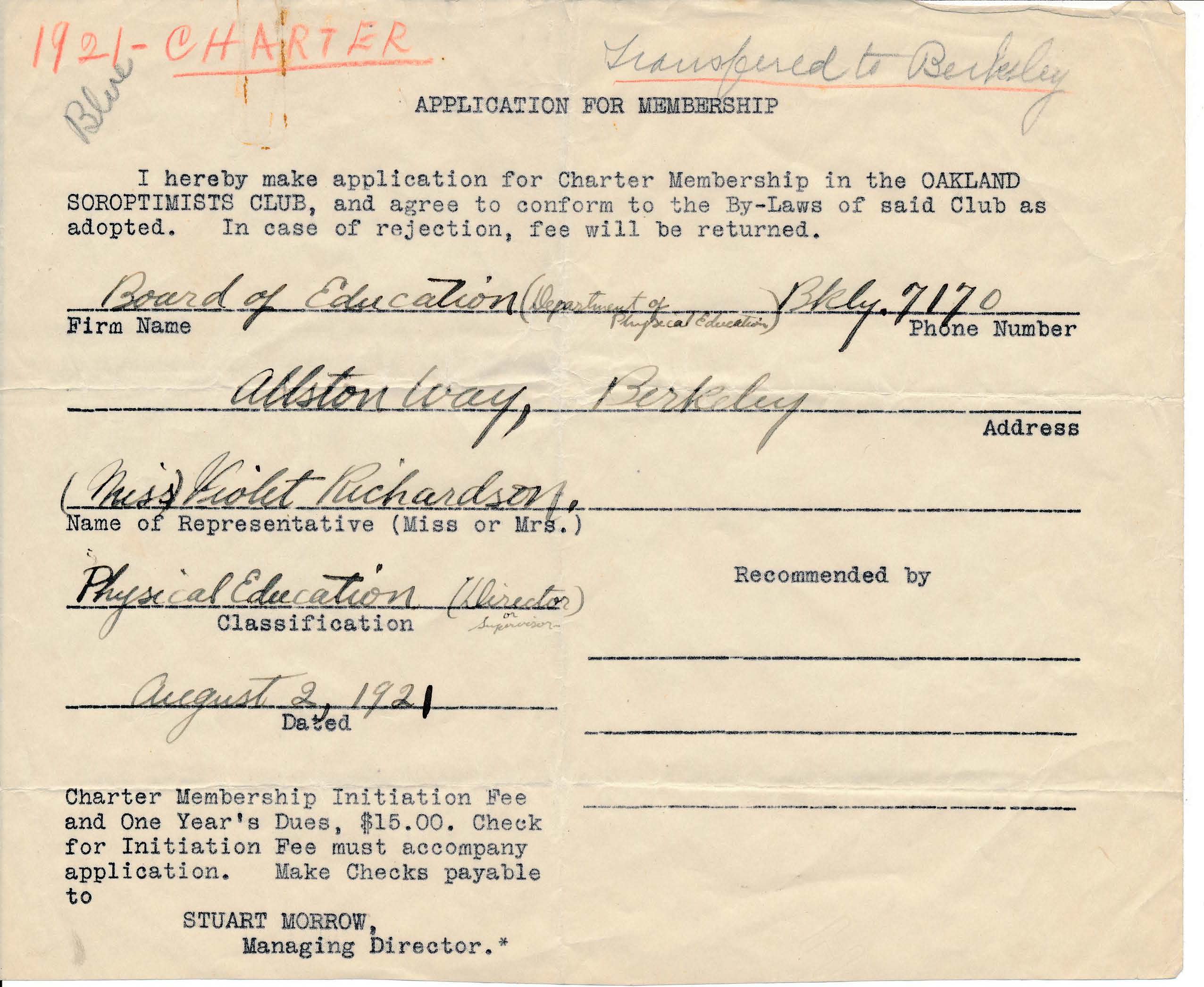
The sixth regular luncheon of the Alameda County Soroptimist Club on August 8, 1921, surpassed any of the previous meetings. A record 27 members were in attendance, the largest luncheon held by the club to that date. Twenty of the members had attended previous meetings, and seven new members were welcomed. Members included:
- Hattie Lehnhardt (Confectioner, Proprietor)
- Mira Merriman (Girls’ School, Principal)
- Anna Gilchrist (Furnishings and Carpets, Partner)
- Jane Flippen (Designer of Batiks, Principal)
- Melvina Rushmore (Interior Decorator Consulting, Principal)
- Alice Glaze (Kindergarten, Principal)
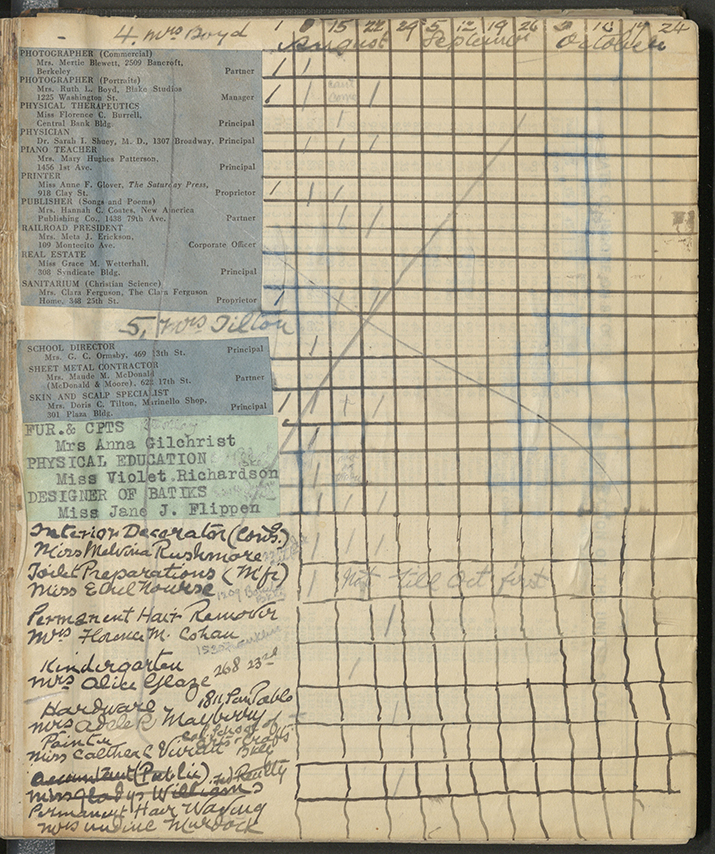
This meeting was also the first meeting Violet Richardson (Physical Education) attended as a Soroptimist member! Including Violet, three of the new members were in the education field, and two were involved with interior decoration and furnishings.
Although Ethel Nourse was listed as attending on this page of the Morrow book, a new attendance section of the book stated she would not be in attendance until October. The name of Alice Glaze was left off the list, but included in the attendance area—which shows that often, we need to look at multiple versions of archival documentation to get a fuller picture of what may have actually happened!
The guests at the meeting were also noteworthy. They were Mrs. Kidd, from the District Attorney’s office, Mrs. Power with the State Employment agency, and the deputy sheriff.
The speaker was Mrs. Hattie Jewel Anderson. Mrs. Anderson had recently been appointed as the receiver of public funds in the San Francisco district land office of the United States Department of the Interior. Florence Harding, a close political advisor to her husband, U.S. President Warren G. Harding, had pressed for Anderson’s appointment to a federal position following the 1920 presidential election.
August 15, 1921
The seventh regular luncheon of the Alameda County Soroptimist Club on August 15, 1921, marked a change in how Stuart Morrow documented attendance. Previously he had always listed the members in attendance along with the “minutes” of the meeting. In early August, with 42 club members listed, he instituted a system of keeping role of the attendees in a chart kept in the inside cover of his workbook (see picture from page of Morrow's book above under August 8, 1921). As new members were added, they were added to the role list, first in a type-written appendage, and then by hand.
Morrow’s minutes of the meeting note 25 members in attendance in addition to himself, along with two visitors. Mrs. Poindexter, the featured speaker, spoke about “lip reading.”
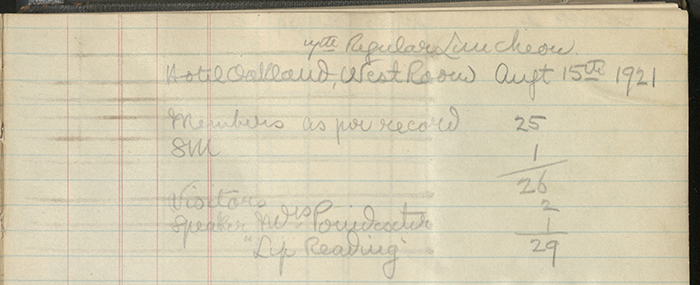
August 22, 1921
Information regarding the eighth regular luncheon meeting of the Alameda County Soroptimist club is the sparsest that Stuart Morrow provided. Morrow reported 29 members in attendance (although only 27 can definitely be accounted for in his role chart). New members included Florence Cohan (Permanent Hair Remover, Principal) and Adele Mayberry (Hardware). Gladys Williams (Public Accounting) is also listed as attending the meeting as member in Morrow’s roll. She apparently decided to decline membership, as her name is struck out in Morrow’s book, and her name did not appear on the club’s charter. Mrs. Saylor was the featured speaker, but the topic of her presentation as is unknown.

August 29, 1921
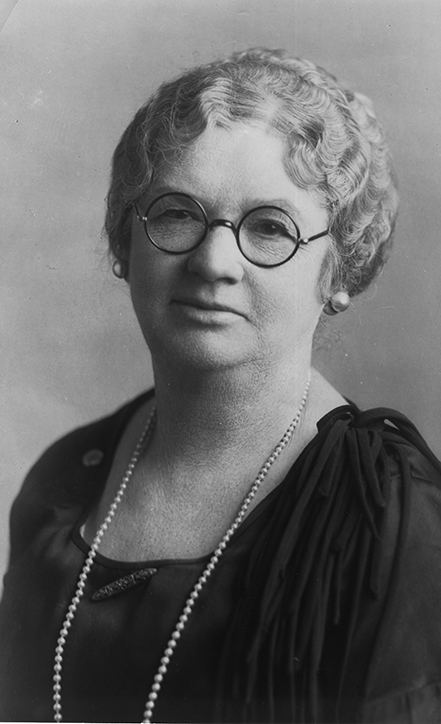
The notes from the ninth regular meeting of the Alameda County Soroptimist Club on August 29, 1921, begin to reveal some of what the members of the new endeavor were thinking. Stuart Morrow recorded that 27 members attended the luncheon, along with two visitors, and the speaker, Mrs. Letitia Andrews. Among the attendees were several new members, including Undine Murdock (Permanent Hair Waving, Principal), Irma Randolph (Professional Singer), and Helena Gamble (Campaign Manager).
Gamble would become one of the most influential founders in the coming years. She worked to charter new clubs with Morrow, and after the federation was formed in 1928, was appointed as its historian. It is to Helena Gamble’s collection of historical documents, which were donated to SIA headquarters in 1996, that we owe our ability to tell the story of the first club’s formation through this blog, and other information on the earliest years of Soroptimist.
During the meeting, Morrow recorded some phrases that should still resonate 100 years later (visible below in the notes):
We meet for "Recognition + Cooperation"
Result = Service
Perhaps the most prophetic statement is the final one inscribed in his notes:
"A big movement has been started by this club."
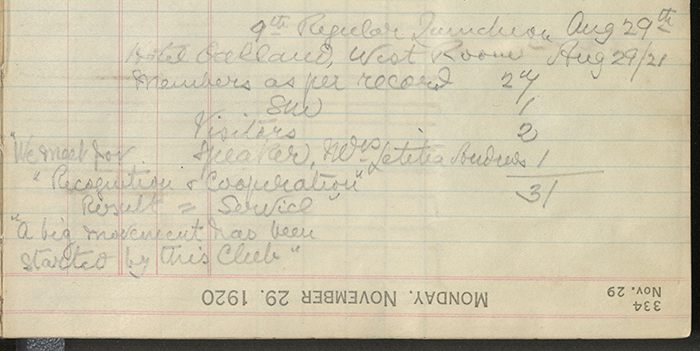
September 12, 1921
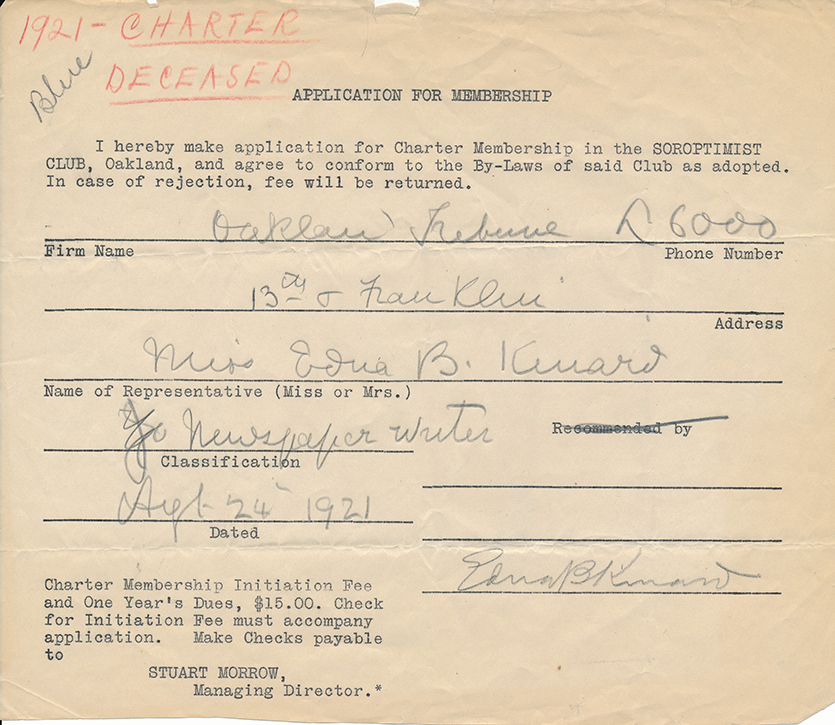
The Alameda County Soroptimist club met for its 10th regular meeting after breaking the previous week in recognition of Labor Day. Morrow’s notes from this meeting are limited to noting the attendance at 43 members from the register, as well as seven visitors and late members.
Edna Kinard, a “newspaper writer” for the Oakland Tribune, served as the meeting's speaker. While her membership application notes she was on Morrow’s radar as a potential member in August, she paid a portion of her charter fee and attended her first meeting on this day. Morrow quoted Kinard in his notes: “We must know our city in order to boost it.” Even before the club chartered, the club was considering how to make Oakland and Alameda County better by its efforts.
The club was now just two weeks from closing its charter and electing its officers and board. Morrow had stopped noting attendance in his book in any form, and it became more difficult to determine when new members joined the club.
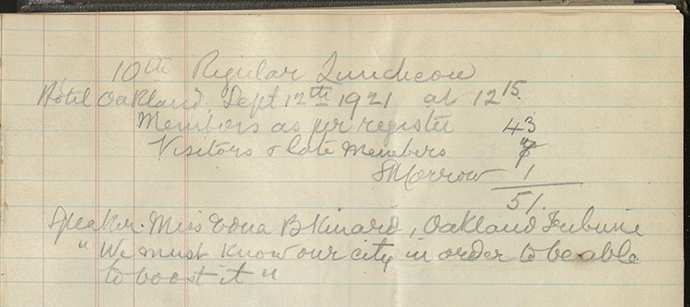
September 19, 1921
This day marked the 11th and final regular luncheon of the Alameda County Soroptimist club. For the first time, Morrow did not note attendance in any way, and simply stated: “Informal discussion on matters to be voted on on Sept 26th.”
September was a particularly busy time for new members and the final collection of the $15 per member chartering fees which were, in effect, Morrow’s salary for organizing the new club. From the end of August through September over one quarter of the charter members joined the club.
- Mabel Allen (Public Speaking and Dramatic Art, Principal)
- Sarah Ann Barrett (Loan Officer, Principal)
- Waly M. Beltink (Library-Circulating, Partner)
- Edna Brown (Life Insurance, Principal)
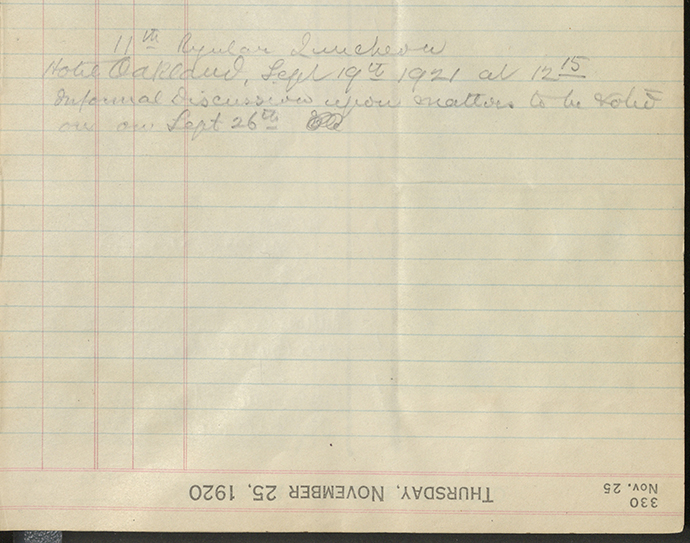
Notes from the 11th regular meeting. - Virginia Diehl (Hair Good & Novelties, Partner)
- Pauline Drennan M.D. (Surgeon, Principal)
- Louise Gans (Public Accountant, Principal)
- Hilda Gascoigne-Coulter (Chiropody-Surgery, Principal)
- Madeline Gibbons (Corsets and Blouses, Partner Associate)
- Helen Glenn (Bakery, Principal)
- Carroll Greenleaf (Building Contractor, Partner)
- Isabel Jenkins (Jewelry, Partner)
- Myrtle Lent (Accompanist, Principal)
- Ettie McCall (Ladies Cloaks and Suits, Partner)
- Margaret Paige (Pianos and Player Pianos, Partner)
- Pearl Rogers (Registered Nurse, Principal)
- Rose Starr (Auto Service and Repair, Partner)
- Edna Sugden (Dressmaker, Principal)
- Ida Theurer (Hotel, Principal)
- Alma Thorne (Bank of Italy, Department Manager)
- Emily Wilkie (Editor University Press, Principal)
- Iva Young (Nurse-Christian Science, Principal)
The members were ready to complete organization and would elect their club’s first leaders the following week.
September 26, 1921
The “first annual meeting” of the Soroptimist Club of Alameda County was held on September 26, 1921. During the meeting Morrow announced the charter list of members was closed as of that day, with 80 members on the list, and approximately 50 members in attendance.
The main business of the meeting was to elect its board and officers. While Morrow’s minutes of the meeting are very straightforward, and simply note the election of Violet Richardson as president, and Sue Ballard as vice president, we know from statements made later by Violet that she was elected on the third ballot as president, and that Sue Ballard received the next highest number of votes which secured the position of vice president.
Initial decisions by the club included having two separate positions for secretary and treasurer, and to have the secretary appointed by the board (which happened one week later at its first meeting). In a separate ballot, Nellie Drake was elected treasurer.
The members undertook yet another ballot to elect five board members: Edna Kinard, Doris Tilton, Gladys Leggett, Blanche Rollar, and Adelaide Goddard.
This meeting also established the club’s financial footing. While members had paid $15 each to Stuart Morrow in charter membership fees (approximately $230 in today’s dollars) as club organizer and managing director, that money was kept by Morrow. He noted the following in the minutes: “A ballot was taken upon the question as to what would be the monthly dues of the Club and same were by a large majority fixed at $1.50 per month.”
Following a standing vote of thanks by the members of the club for Morrow, the meeting concluded.
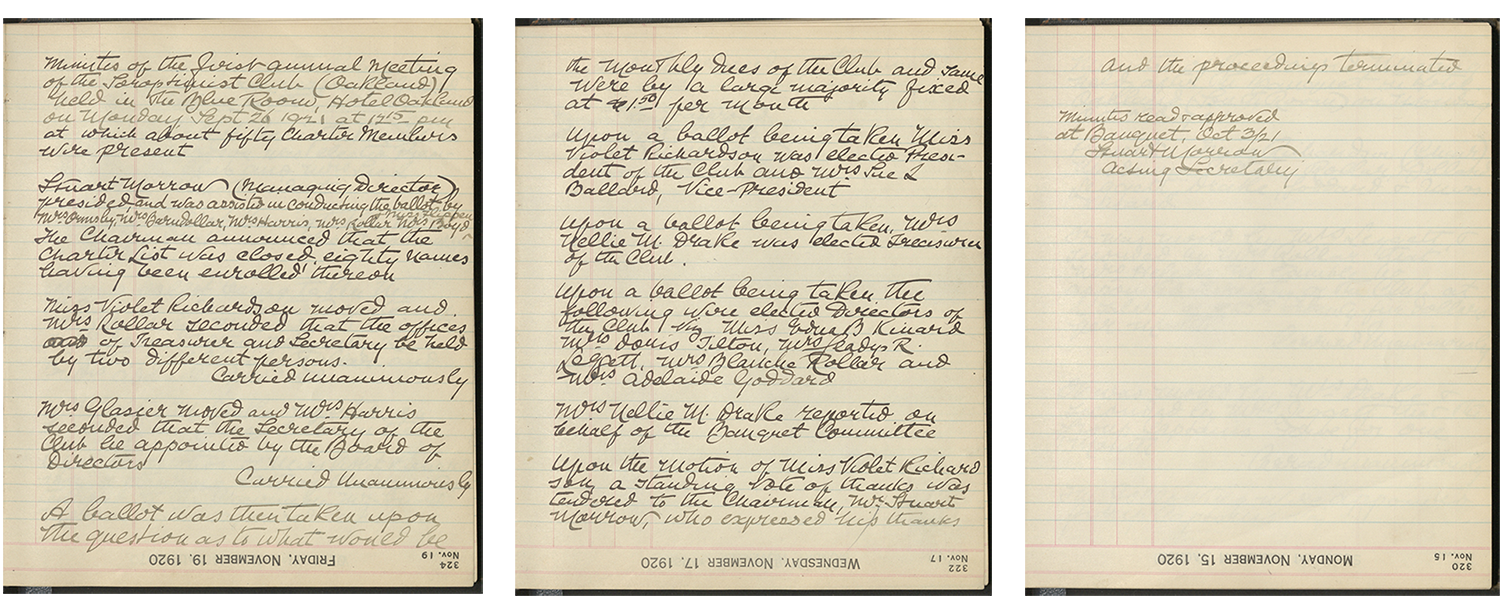
October 3, 1921—Founders Day
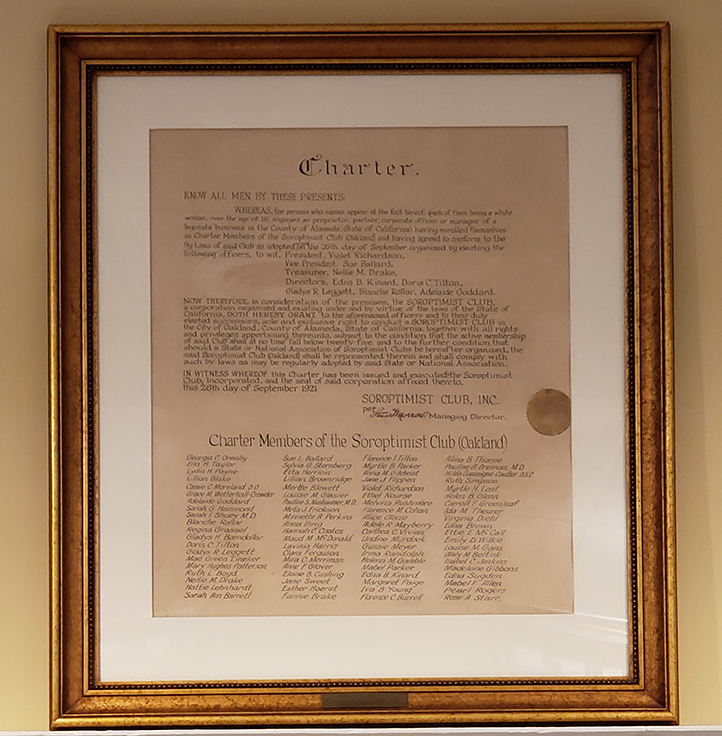
October 3 is acknowledged in Soroptimist as Founders Day. On this date in 1921, Soroptimists held the first Soroptimist Club of Alameda County board of directors meeting, followed by the first charter banquet in Soroptimist history.
Board Meeting
The previous week, the members had determined the Soroptimist Club of Alameda County would have a club secretary appointed by the club’s board. Helena Gamble was appointed as club secretary at this first board meeting, and the board also determined it would pay her a salary of $25 per month. It was not unusual to have an appointed secretary, but it was unusual to have a paid secretary. It is likely the club leaned on Stuart Morrow’s belief the secretary should be paid, as he had been a paid secretary for a Rotary club in Ireland. However, what Morrow may have left unsaid was this paid position probably was the beginning of his eventual difficulties within that organization. In later years, the transcripts of an oral history interview with Kay Davis in 1970 show Violet Richardson Ward was not in favor of that particular practice:
Violet Richardson Ward: Helena Gamble was a paid secretary. And I have always opposed having any paid officer in the club. I think it's very, very unwise.
Kay Davis: I didn't know anybody ever did.
Violet Richardson Ward: Well, Oakland did. And, uhm, it was very, very, very unwise. That's all I can say about that.
The board appointed a committee to draft the club Constitution and Bylaws, consisting of Eloise Cushing (a lawyer), Emily Wilkie and Dr. Pauline Nusbaumer. The board also determined group captains would serve for one month, encouraging members of their group to attend the regular weekly luncheon meetings, and named the first set of captains.
Finally, the board moved and approved the president to be the speaker at the next luncheon meeting, to lead the discussion to “outline the aims, objects & aspirations of the club.” In response, Violet Richardson asked each board member to send her a letter outlining their thoughts on the “aims, objects & aspirations of the club.” It was also agreed to provide notice of the members of this topic of discussion so each member could consideration to it “so as to be able to express their views at the luncheon.”
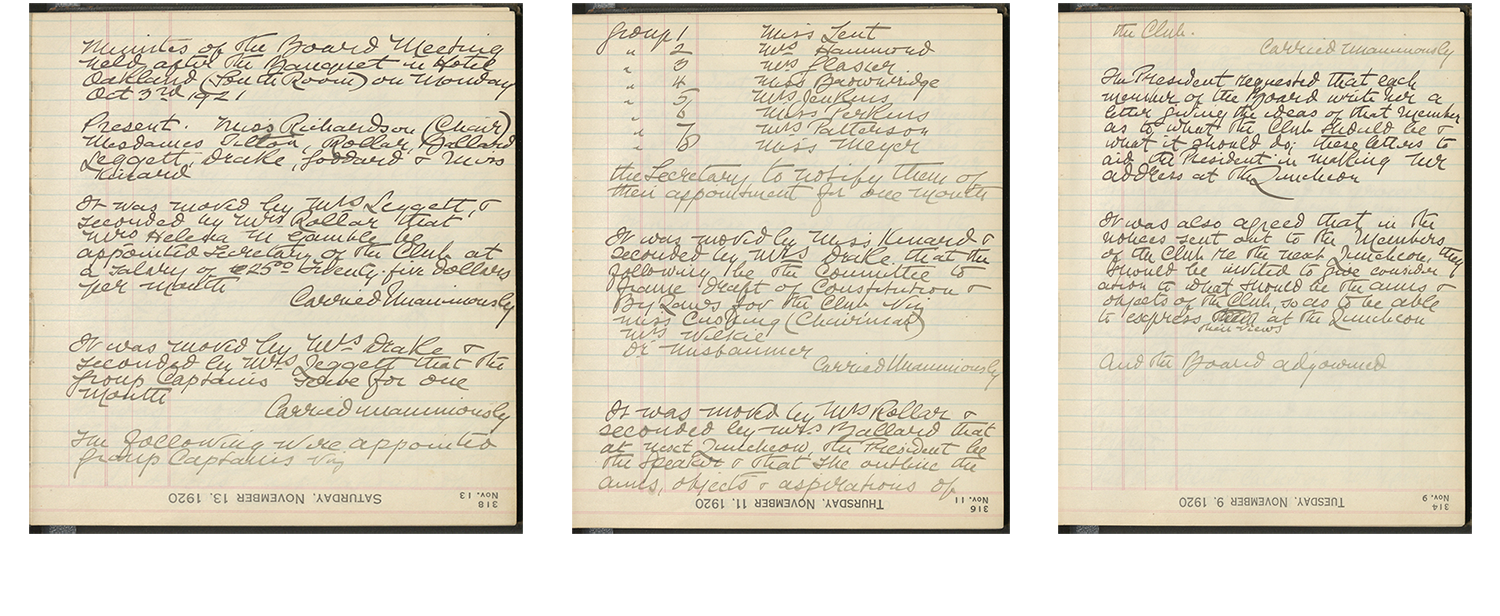
Charter (Annual) Banquet
The banquet, and the minutes documenting the event, mark the end of Morrow’s active involvement with the Soroptimist Club of Alameda County. As he was chartering clubs, Morrow noted to those charter members that once chartered, their club was completely independent, and free to carry out its work as it saw fit. Morrow recorded this last event in the “Morrow Book” as follows (with abbreviations corrected):
Proceedings at the first annual banquet of the Soroptimist club held in the South Room, Hotel Oakland, on Monday evening October 3rd 1921 at 7:00 pm
Mrs. Drake has list of those present
Stuart Morrow opened the proceedings, by calling for the first verse of “America” which was sung by all present (Miss Lent at the piano)
Stuart Morrow, as Chairman of the first annual meeting, reported that Miss Violet Richardson had been duly elected president of the club and requested that she be escorted by Mrs. Ballard and Mrs. Drake to the president’s chair at the head of the table
This was done amid applause for Miss Lent playing appropriate March
The President called on Mr. Morrow as acting secretary to read the minutes of the first annual meeting
This having been done and there being no objection the minutes were approved as read after which the president addressed the club
Mrs. Ballard, who was in charge of the entertainment program, then called on the following ladies:
Mrs. Randolph Songs
Miss Lent Piano solo
Miss Brookridge YWCA short address
Miss Lobner President of ? Woman Club short address
Mrs. Kidd Vice President Business and Professional Women short address
Mrs. Ruth Boyd on behalf of the club presented Mr. Stuart Morrow with a handsome old pencil in appreciation of his services.
Mr. Stuart Morrow expressed his very sincere thanks and in short address presented the president with the club charter
Mrs. Drake on Behalf of the Club presented the president with a magnificent basket of flowers
The President expressed her acknowledgements and moved a cordial vote of thanks to Mrs. Drake as chairman of the Banquet committee, Mrs. Ballard Chairman of the Program Committee and to the several ladies who had contributed there to which was carried by acclamation and
The proceedings terminated.
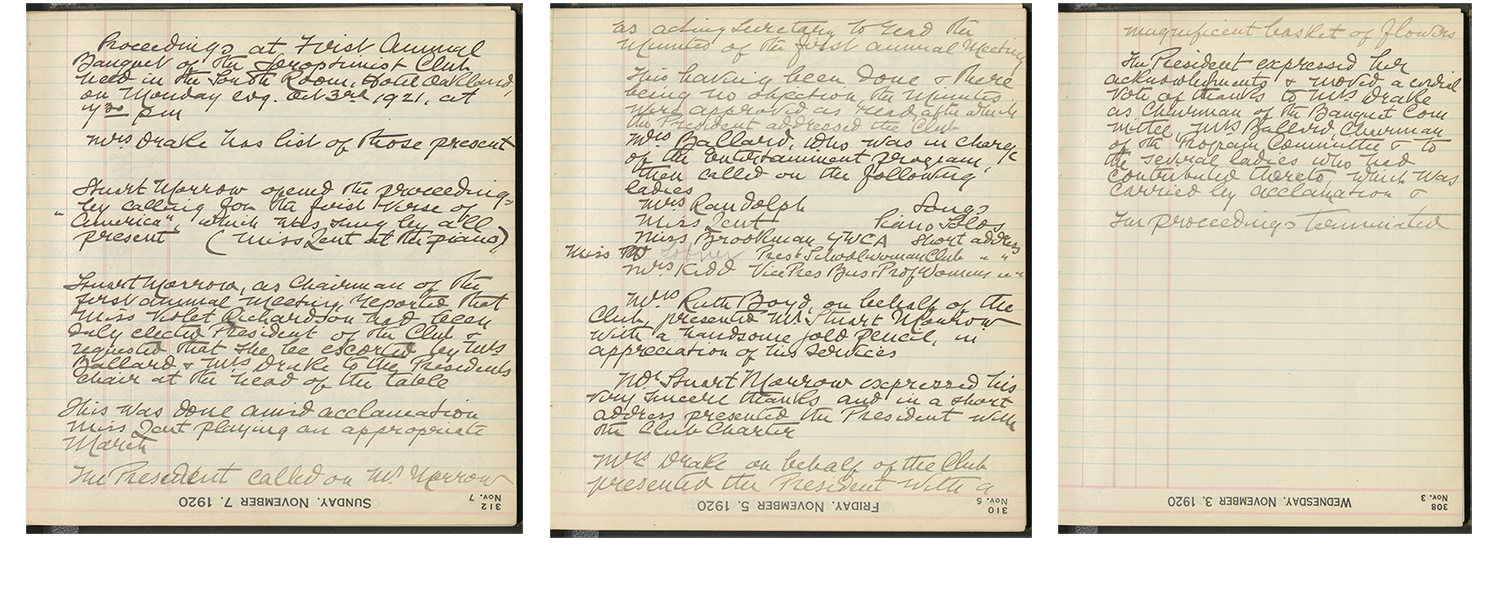
The program is especially notable for the representatives of other women’s groups who welcomed this newest organization to their fold. Miss Brookridge of the YWCA, had attended two meetings in mid-July, and would soon work with the club as it established its first service project.
The charter Morrow presented to the club required membership could not fall below 25, and if a state or national association of Soroptimist clubs were organized, the club would be represented in that organization and comply with its adopted bylaws. The charter also contained information that membership was confined to white women. Several clubs noted in subsequent club histories written in the 1930s they repudiated this statement as soon as they received their charter, and it may reflect Morrow’s own personal bias. The first club charter after Soroptimist clubs bought him out of his interests in the organization in 1927 made no mention of racial preferences for members.
Following this banquet, Morrow turned his attention to organizing a club across the bay in San Francisco, while the Soroptimist Club of Alameda County began its operations, which we will follow through their weekly meeting agenda announcements for the next few months.
October 10, 1921
The Soroptimist Club of Alameda County had its first general meeting on October 10, 1921. As determined by the club’s board of directors the previous week, this meeting’s agenda was dedicated to discussion on the “Aims and Ideals” of the club. The meeting notice, sent by the group captains and dated October 6, advised the President (Miss Violet Richardson) would present her ideas, and desired members should share theirs as well in open forum.
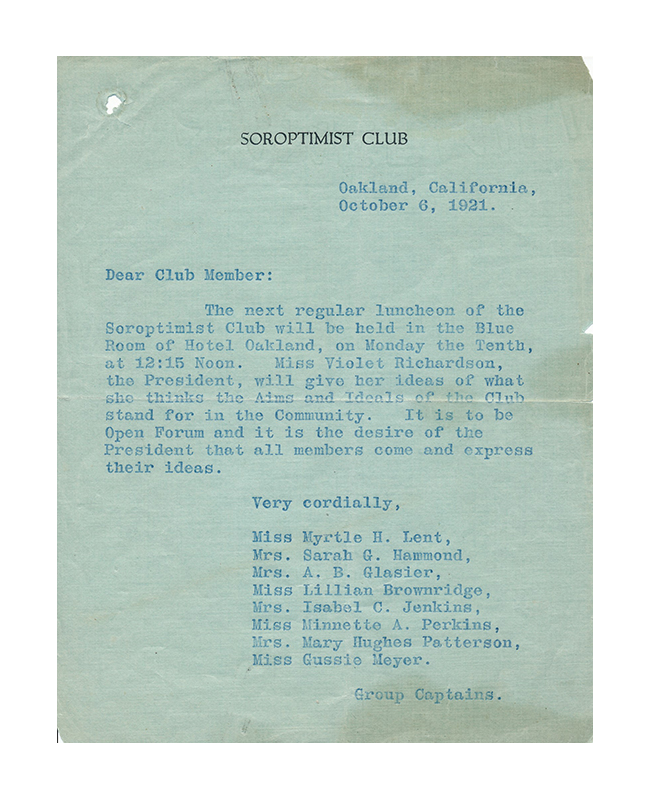
October 17, 1921
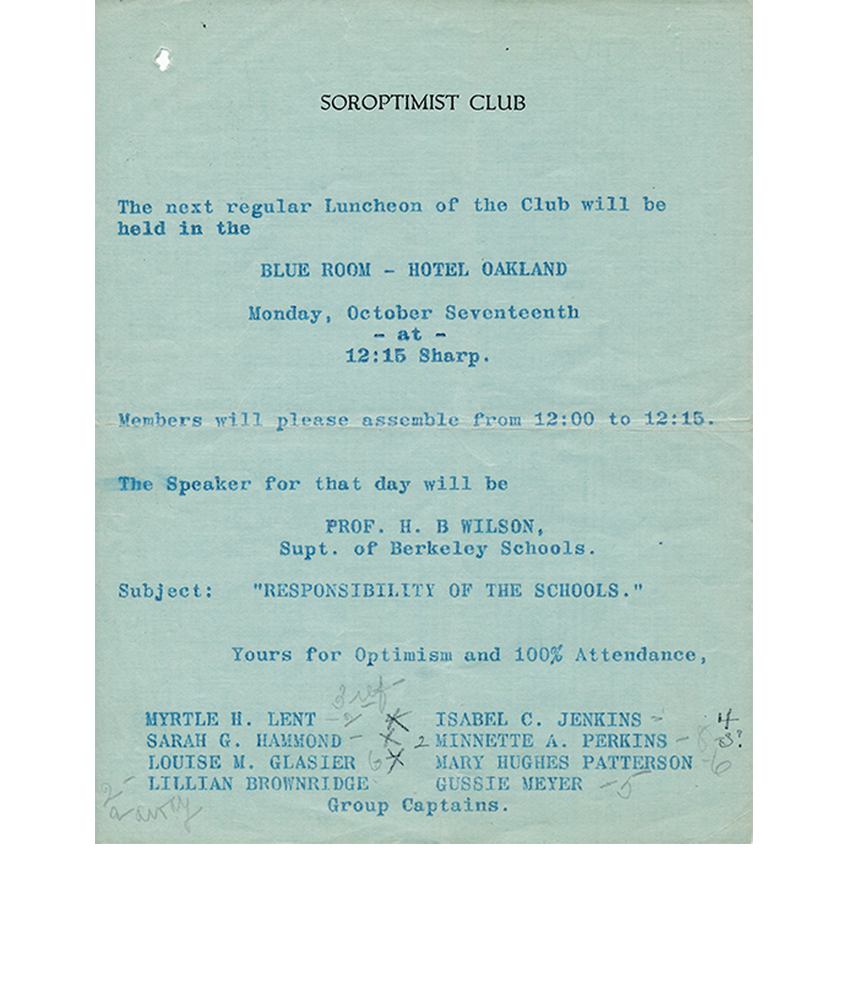
For the first time since it’s chartering, the Soroptimist Club of Alameda County welcomed a guest speaker to their meeting on October 17, 1921. Club President Violet Richardson served as the director of physical education for the Berkeley school district. As the first guest to address the club, Violet chose the superintendent of Berkeley Schools, Professor H.B. Wilson.
This agenda, and all the early agendas the SIA archives has in its care, were among the historical papers that belonged to club secretary, Helena Gamble. It is likely these agendas were Helena’s personal copies, and it is interesting to note the penciled notations at the bottom of the page. Beside the group captain names are numbers, and from the records of the club, we know that there were eight groups with 10 members in a group. Group captains changed monthly and helped encourage members to attend the weekly meetings. We can’t be sure if the numbers refer to absences (although that is the most likely explanation given there is a notation in the bottom right corner that looks like “2-away”). It looks like there may have been three potential members referred to the club, and out of the 80 charter members, 30 members were absent—nowhere near the wish of “Yours for Optimism and 100% Attendance.” These types of notations are noticeably missing on subsequent copies of the agendas.
October 24, 1921
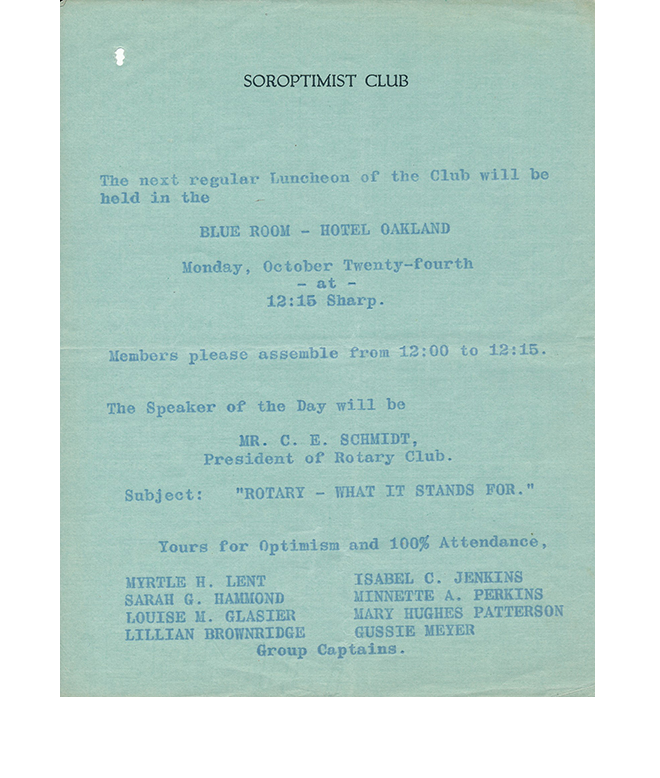
The formation of the Soroptimist Club of Alameda County was grounded in the experiences club organizer Stuart Morrow had refined as a Rotary member and Rotary club organizer in Ireland and England. So it should not be a surprise that in its third meeting after receiving their charter, the Soroptimist club invited the president of the Oakland Rotary club, Mr. C.E. Schmidt, to their October 24 meeting to learn more about that organization.
Interestingly, Rotary also influenced the formation of another woman’s club. The Venture Club of Bristol, England, was formed with the active assistance of Bristol’s Rotary club in 1920. The Rotary club also provided a meeting space and assistance printing the Venture club’s news for a number of years.
More Venture clubs were formed in the years ahead, with at least one other directly assisted by a Rotary club. The Association of Venture Clubs decided to join with the Soroptimist clubs in Great Britain in 1930, dropping the name Venture and known thereafter as Soroptimist clubs.
In 1934, the name “Venture” was chosen by the Junior Soroptimist clubs in North America (clubs of young women not yet professionally eligible to be Soroptimists) as their new name to perpetuate and pay honor to the earliest Venture clubs that had formed parallel to Soroptimist clubs in the 1920s.
October 31, 1921
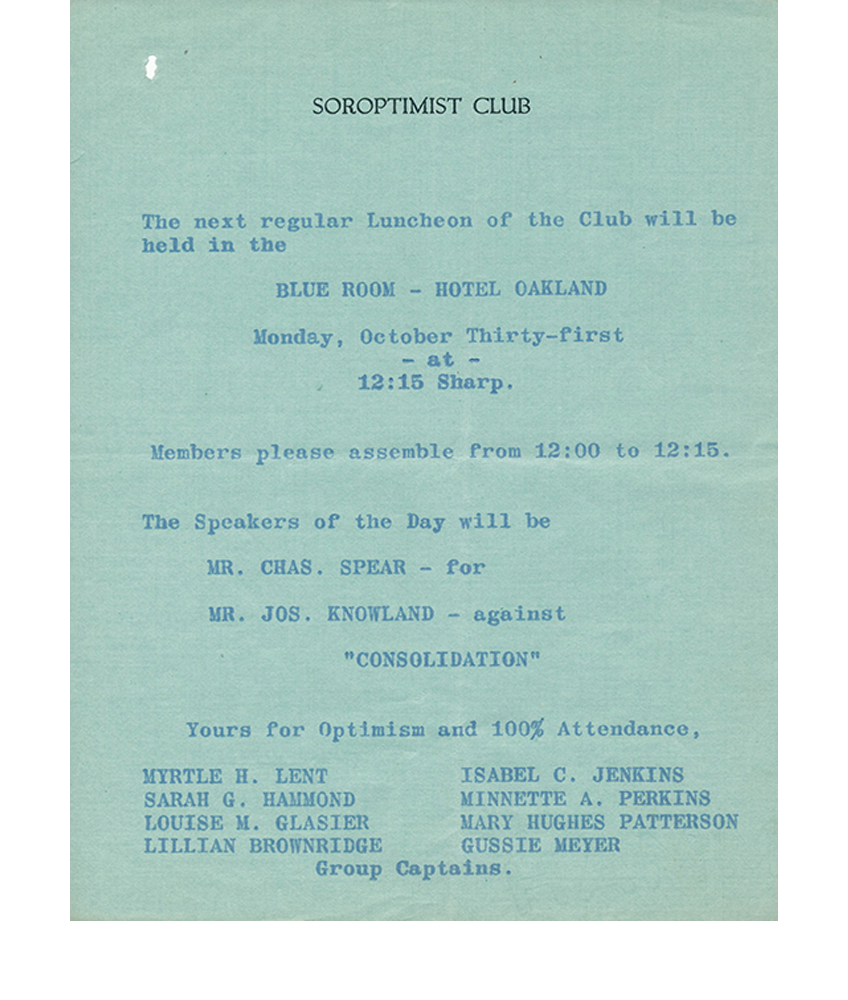
For its October 31, 1921 meeting, the Soroptimist Club of Alameda County hosted two speakers. At the time, a large political decision was on the November 1921 local election ballot—whether to consolidate a number of municipalities on the San Francisco Bay’s east side, including Oakland and Berkeley.
The club hosted Mr. Charles Spear speaking “For” consolidation, and Mr. Joseph Knowland speaking “Against” consolidation, giving each speaker the opportunity to state their case. This was an important civic matter, and the club was putting into practice what it would state as its purpose a few months later in its printed Constitution and Bylaws: “The purpose of this organization is to foster the ideal of service as the basis of all worthy enterprises and to increase the efficiency of its members in the pursuit of their occupations by broadening their interests in the social, business and civic affairs of the community through an association of women representing diverse vocations.”
In 2021, journalists at the East Bay Times are looking back at this important civic ballot initiative, which prompted the first presentation of opposing viewpoints on a civic matter at a Soroptimist club meeting.
November 7, 1921
The November 7, 1921, meeting of the Soroptimist Club of Alameda County was the first since October 10 where the agenda was focused solely on internal matters—the formation of the club’s constitution and bylaws.
While it is not overtly stated, this conversation was no doubt led by the bylaws committee appointed by President Violet Richardson. The committee included Chair Eloise Cushing (an attorney) and members Dr. Pauline Nusbaumer (who ran a medical laboratory) and Emily Wilkie (an editor at the University of California Press in Berkeley). This was the first of two conversations about the club’s governance in November. The November 21 meeting would also be focused on the topic.
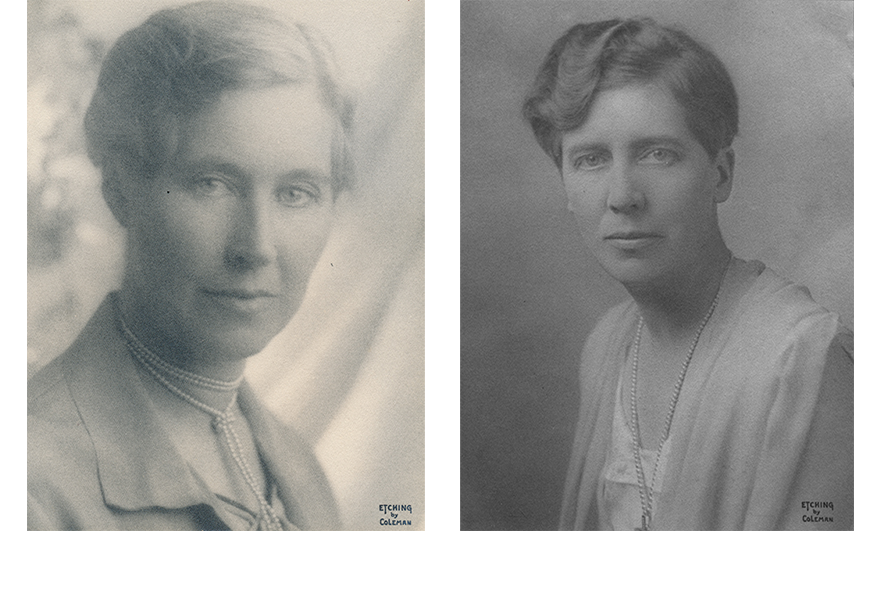
This agenda also notes the new group captains, who would serve during November and December. Attendance at the weekly meetings was a pillar of Soroptimist club operations, and the goal was for 100% attendance. This level of member engagement was viewed as crucial to the development and success of the club, with members representing so many different professions that might not normally come into contact with one another. Group captains were charged with reminding, encouraging, and ensuring as many members of their group—roughly 10 members—would attend the meetings.
November 14, 1921
The Soroptimist Club of Alameda County turned its November 14, 1921, program over to club treasurer Nellie Drake, the owner of Drake Catering Company. Drake had been one of the earliest members to join the chartering efforts in June 1921.
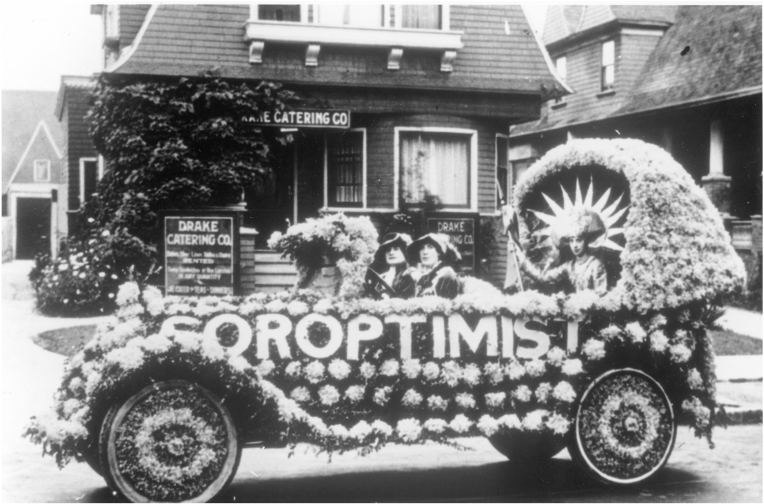
In her oral history interview with Kay Davis in 1970, Violet Richardson Ward described the Drake Catering company as, “…the largest catering company in the state of California...” The SIA archives can’t validate that claim, but one of the best loved and most requested photos of this early era was taken in 1922 in front of the Drake Catering Company at 3021 Telegraph Road.
The original Soroptimist parade “float” photograph shows driver Violet Richardson Ward and Nellie Drake in front, and an unidentified individual with the headdress in the backseat. This information was noted on the envelope holding a negative of the picture that came to the archives in 2019 from Violet’s granddaughter, Sandra Ward West.
This agenda shows the club also started to branch out beyond their club meetings. The first notice appeared this week for a social event—a theatre party on Friday, December 2—at the Fulton Theatre in Oakland.
November 21, 1921
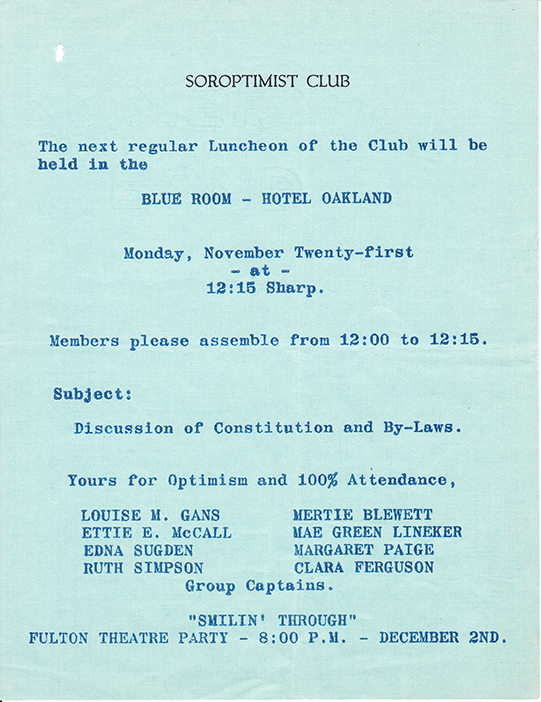
During its meeting on November 21, 1921, the Soroptimist Club of Alameda County focused again on the development of the club’s constitution and by-laws (as it had done during it November 7 meeting). The expectations of membership began to come into focus—members could pay their $18 annual dues (equivalent to $278 in 2021) in monthly installments of $1.50.
Members would be considered in good standing if they did not have any arrears of more than 30 days or had not missed more than five out of nine meetings “without proper excuse.” Members in arrears after 30 days would be placed on the suspended list, and unpaid debts of 90 days would lead to forfeiture of membership.
Unlike modern clubs, the Soroptimist Club of Alameda County operated on a calendar year basis. The first group of officers served from October 1921 through December 1922, and officers were elected in December for the upcoming year. This calendar would be followed by subsequent Soroptimist clubs until the mid-1930s.
The club also put in place strict limits on political activity, stating:
“This Club shall at no time endorse or recommend any candidate for public office, nor shall political candidates or partisan questions, as such, be discussed at any club meeting.
No officer or member of this Club shall use the Club as a means of furthering any political or other aspirations nor shall the Club as a whole take an active part in any movement not in keeping with the real purposes and objects of the organization.”
There is no further mention of club discussion for the remainder of the calendar year on the club’s agendas; this second discussion looks to have been the final one on the club’s governing documents.
November 28, 1921
A notice in the “Pacific Coast Musical Review” for January 1, 1921, noted Randolph, a soprano, sang with the American Light Opera Quartet and, “This organization renders selections from light and grand operas, and their success justifies them to expect frequent public appearances during the season.” For its final meeting of November, the Soroptimist Club of Alameda County left business and civic awareness to the side. The program for this meeting focused on a musical presentation by charter member Irma Randolph.
Musical offerings weren’t the only arts offering on this meeting’s agenda. The note at the bottom of the agenda reveals the club’s theatre party was to see the play “Smilin’ Through,” written in 1919 by Jane Cowl and Jane Murfin (under the pseudonym Alan Langdon Martin).
This drama, focusing on two generations of ill-fated love, would be turned into a silent film in 1922, and filmed twice more as a “talkie” in 1932 and 1941.
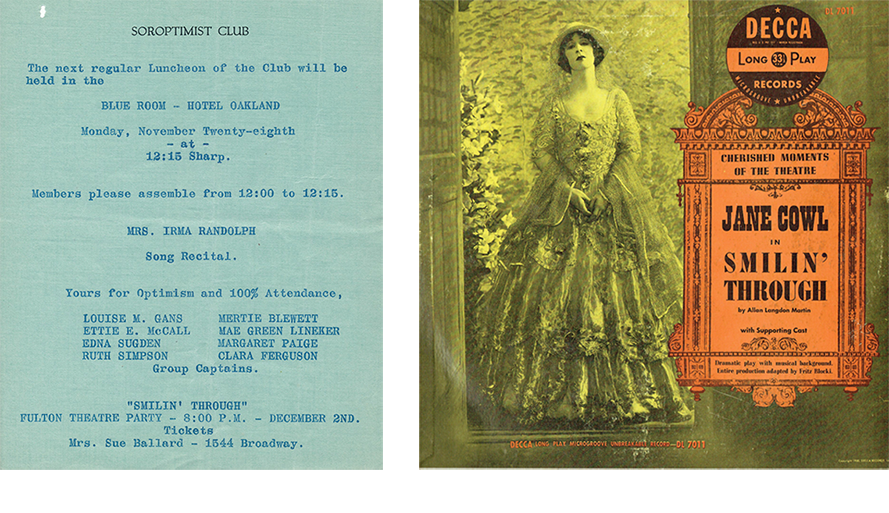
December 5, 1921
The first December of the Soroptimist Club of Alameda County picked up the thread of civic awareness with speaker Jay Nash, the Oakland city superintendent of recreation. At the time, Nash was working to establish a municipal golf course on an undeveloped parcel with views of the San Francisco Bay. It appears Nash was a last-minute replacement for the announced speaker, who would come to the December 12 meeting instead. Nash was no doubt well-known to Violet Richardson through their mutual interests in recreation.
But on a somber note, the club also recognized the loss of charter member Dr. Sarah Shuey, 70, who died suddenly on November 22. This loss would have been announced at the November 28 meeting, and noted for memoriam in the agenda for the upcoming December 5 meeting that was sent to all members.
Her obituary in the California State Journal of Medicine (Vol. 20, No. 1, pg. 34) noted she graduated with the first class in medicine in 1876 from the University of California. Shuey was well-known and highly regarded in her profession in the cities along the East Bay, and when she passed, she was serving as an attending physician for the young women in the Alameda County Detention home, as well as on the staff of Oakland’s Merritt Hospital.
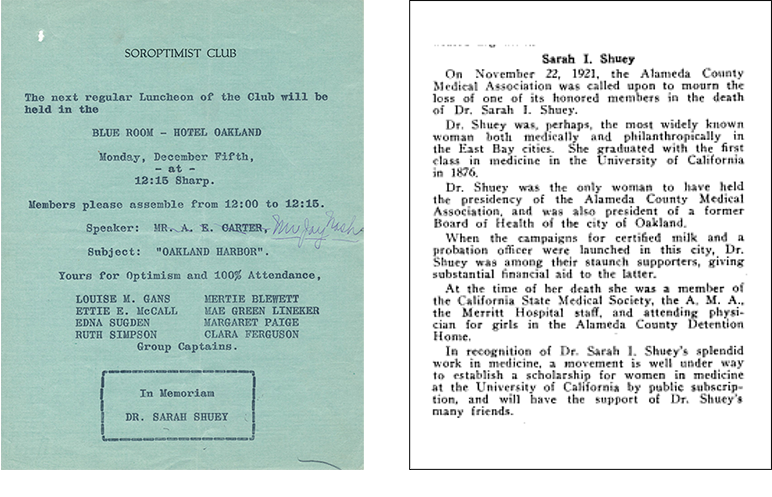
December 12, 1921
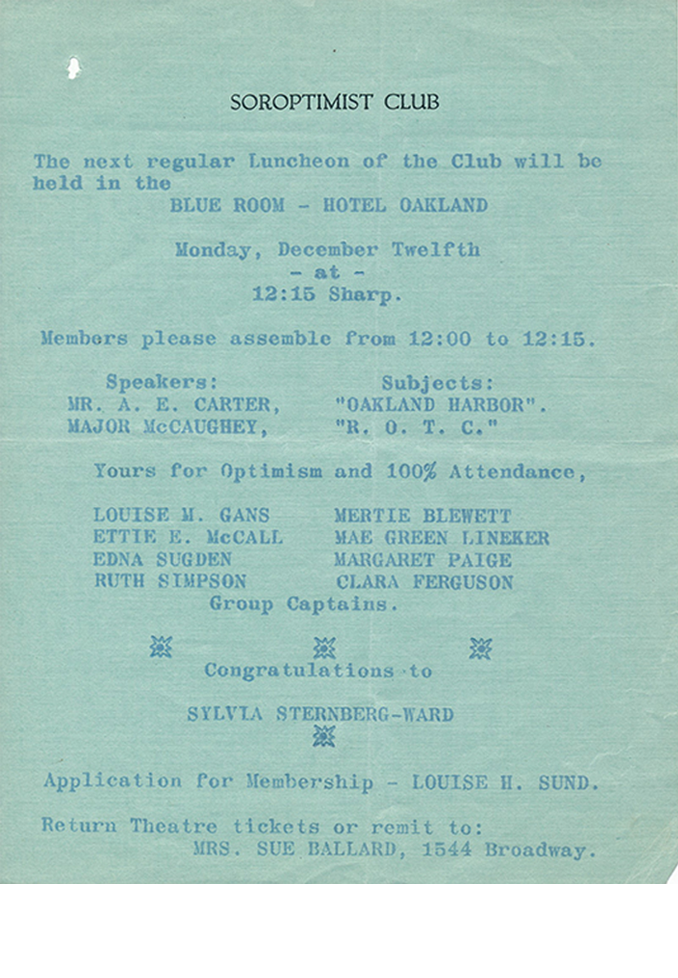
On this day, the meeting of the Soroptimist Club of Alameda County focused once again on civic information in support of the club’s purpose “to increase the efficiency of its members in the pursuit of their occupations by broadening their interests in the social, business and civic affairs of the community through an association of women representing diverse vocations.”
Mr. A.E. Carter spoke on the Oakland Harbor; during 1921 a project began to dredge channels in the harbor to increase traffic to the port in Oakland. The second speaker, Major McCaughey spoke on the Reserve Officers’ Training Corps, or R.O.T.C., which expanded after national legislation in 1920.
The agenda notes that the club had an application for membership from Louise Sund, a corporate officer (treasurer) of a curtain store in Oakland. She was admitted to membership and is listed in the 1922 roster of members. The club also sent its congratulations to charter member Sylvia Sternberg, who had recently married, and was listed as Sylvia Ward in the 1922 roster.
December 19, 1921
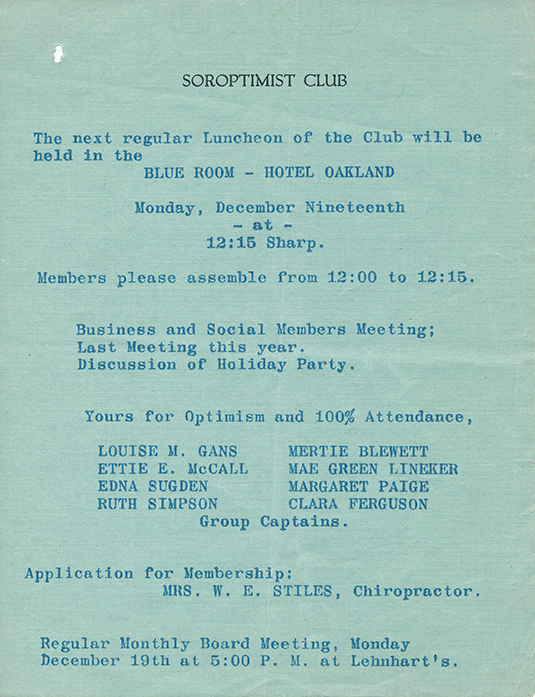
The monthly business meeting of the Soroptimist Club of Alameda County on December 19, 1921, focused on year-end social and holiday gatherings at this last meeting of the year. There’s no indication when the holiday gathering took place that was discussed at the meeting, but after seven months of formation, it was surely a festive event. The club took an extended holiday break, and would not meet again until January 16, 1922.
Member recruitment continued at this last meeting of 1921. Marie Stiles, a partner in a chiropractic practice, was announced as a prospective member. She was admitted to membership and is listed in the 1922 membership roster.
The board members were also reminded of their meeting the evening of December 19 at Lehnhardt’s, which was the candy and confectionery business of charter member Hattie Lehnardt. An Oakland history blog notes that on October 8, 1921—only days after the charter event for the new Soroptimist club—Lehnhardt’s gave away 5,000 boxes of candy for the first National Candy Day. Given Lenhardt’s generosity, the Soroptimist club board must have had a very sweet final meeting of the year!
